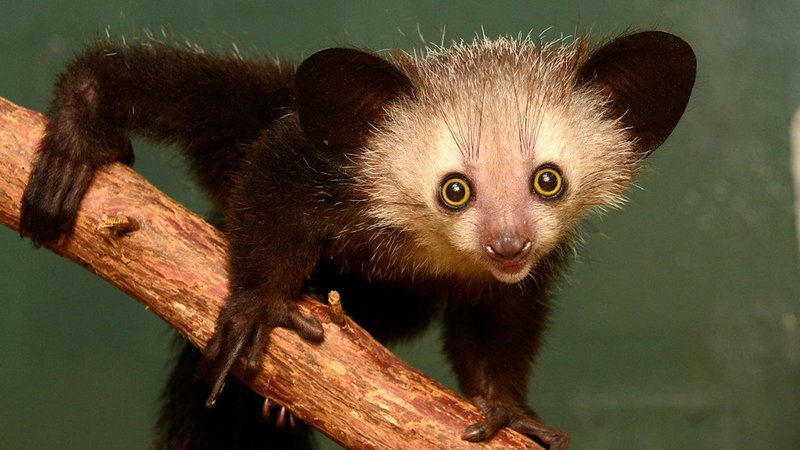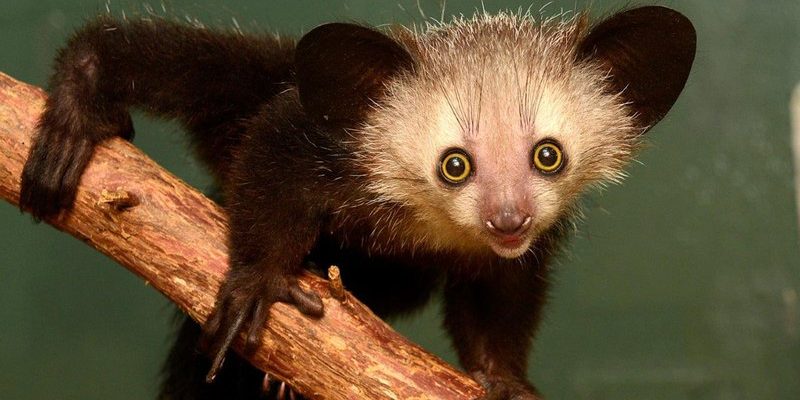
Think of the aye-aye as nature’s oddball. It has a unique way of finding food—tapping on tree trunks to detect grubs, then using its elongated middle finger to extract them. Despite its quirky lifestyle, the aye-aye has been misunderstood throughout the years, often linked to superstitions and myths. Understanding what makes the aye-aye tick can help shed light on how it interacts with humans and whether we should fear it.
What is the Aye-Aye?
The aye-aye is a lemur, belonging to the family Indriidae. It stands out due to its peculiar features, such as large eyes that help it see in the dark. This nocturnal primate relies on its hearing and unique feeding techniques, making it a fascinating subject for researchers.
These animals have a distinctive look: they have large, bat-like ears and a tail that’s longer than their body, giving them a whimsical appearance. Aye-ayes weigh about 5-10 pounds and can grow around 14-17 inches long, not including their tail. Their fur is generally dark brown or black, which helps them blend into the trees of their forest habitat.
You may wonder why they have such long fingers. This specialized adaptation allows them to tap on trees and find insects hiding beneath the bark. Unfortunately, these unusual traits have contributed to myths about their danger level.
The Myth of the Dangerous Aye-Aye
One of the biggest misconceptions about the aye-aye is that it’s dangerous to humans. Much of this stems from local folklore. In Madagascar, people have viewed the aye-aye as a symbol of bad luck or even death. This has led to some unfortunate practices, including the killing of aye-ayes out of fear.
Here’s the thing: aye-ayes are not aggressive. They tend to avoid human contact and prefer their solitary lifestyle among the trees. Most interactions between aye-ayes and humans are harmless, and the idea that they pose a threat is largely unfounded.
Unfortunately, these superstitions can lead to the extermination of aye-ayes, which are already classified as endangered. Education about their true nature is crucial for their protection.
How Aye-Ayes Interact with Humans
Aye-ayes generally keep to themselves; they live in trees, far from the hustle and bustle of human activity. However, as human populations expand and their habitats shrink, the chances of a brush with these creatures increase.
When aye-ayes encounter people, they usually show signs of fear rather than aggression. They may flee or hide, using their tree-climbing skills to escape. Most of the time, humans don’t even realize they’re sharing their space with these unique primates.
Despite their rare encounters, there are exceptions. If cornered or threatened, any animal might react defensively. But that’s not specific to just aye-ayes; it goes for many wildlife species. Understanding their behavior can help humans coexist peacefully with these fascinating creatures.
Can Aye-Ayes Transmit Diseases?
You might be wondering about the potential health risks of interacting with aye-ayes. Like many wild animals, aye-ayes can host parasites and diseases potentially transmissible to humans. However, this risk is very low.
In general, the greatest health risks come from being in close contact with any wild animal. Aye-ayes are not known carriers of diseases specifically harmful to humans. That said, taking precautions—like avoiding touch or feeding wildlife—can help minimize any health risks.
Being cautious goes both ways. Aye-ayes thrive in a natural habitat, and encroaching on their space can be dangerous for them, too. It’s best for both humans and aye-ayes to maintain a respectful distance.
Conservation Efforts for the Aye-Aye
Given their endangered status, conservation efforts for the aye-aye are vital. Various organizations and local governments are working to protect their habitats and educate communities about the importance of these unique primates. By dispelling myths and promoting understanding, they help reduce fear and violence against aye-ayes.
Communities around Madagascar have started to embrace the aye-aye as a national treasure rather than a bad omen. Eco-tourism initiatives allow locals to benefit economically from preserving these creatures.
Moreover, researchers continue studying aye-ayes to learn more about their ecology and behavior. This information is crucial for developing effective conservation strategies. The more we understand their role in the ecosystem, the better we can protect them and their habitat.
So, can the aye-aye be dangerous to humans? The answer is pretty clear: they are not dangerous creatures and are far more afraid of us than we are of them. This quirky primate deserves our compassion and understanding instead of fear.
By learning more about the aye-aye and supporting conservation efforts, we can help ensure these fascinating creatures continue to thrive in their natural environment. Let’s work together to protect the aye-aye—after all, they add a unique charm to the world that deserves to be celebrated, not feared.

